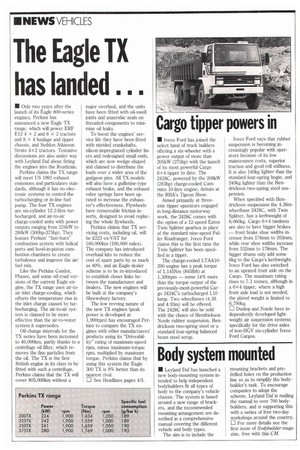The Eagle TX has landed . . .
Page 14

If you've noticed an error in this article please click here to report it so we can fix it.
• Only two years after the launch of its Eagle 800-series engines, Perkins has
announced a new Eagle TX range, which will power ERF E12 4 x 2 and 6 x 2 tractors and 8 x 4 haulage and tipper chassis, and Seddon Atkinson Strato 4 x2 tractors. Tentative discussions are also under way with Leyland Daf about fitting the engines into the Roadtrain.
Perkins claims the TX range will meet US 1991 exhaust emissions and particulates standards, although it has no electronic systems to control the turbocharging or in-line fuel pump. The four TX engines are six-cylinder 12.2-litre turbocharged, and air-to-air charge-cooled units with power outputs ranging from 224kW to 280kW (300hp-375hp). They feature Perkins' "fast-burn" combustion system with helical ports and bowl-in-piston combustion chambers to create turbulence and improve the air/ fuel mix.
Like the Perkins Condor, Phaser, and some off-road versions of the current Eagle engine, the TX range uses air-toair inlet charge-cooling, which offsets the temperature rise in the inlet charge caused by turhocharging. The air-to-air system is claimed to be more effective than the air-to-water system it supersedes.
Oil-change intervals for the TX series have been increased to 40,000km, partly thanks to a centrifuge oil filter, which removes the fine particles from the oil. The TX is the first British engine in its class to be fitted with such a centrifuge. Perkins claims that the TX will cover 805,000km without a major overhaul, and the units have been fitted with oil-swell joints and anaerobic seals on threaded components to minimise oil leaks.
To boost the engines' service life they have been fitted with nitrided crankshafts, silicon-impregnated cylinder liners and redesigned small ends, which are now wedge-shaped and claimed to distribute the loads over a wider area of the gudgeon pins. All TX models will also have a guillotine-type exhaust brake, and the exhaust valve springs have been uprated to increase the exhauster's effectiveness. Flywheels have removeable friction inserts, designed to avoid replacing the whole flywheels.
Perkins claims that TX servicing costs, including oil, will be £223 ex-VAT for 160,000ktn (100,000 miles). The company has introduced overhaul kits to reduce the cost of spare parts by as much as 40%, and an Eagle dealer scheme is to be re-introduced to establish closer links between the manufacturer and dealers. The new engines will be built at the company's Shrewsbury factory.
The low revving nature of the new TX engines (peak power is developed at 1,900rpm) has encouraged Perkins to compare the TX engines with other manufacturers' products using its "Driveability" rating of maximum-speed rpm, minus maximum-torque rpm, multiplied by maximum torque. Perkins claims that by using this system the Eagle 300 TX is 9% better than its nearest rival.
See Headlines pages 4/5.




















































































































































